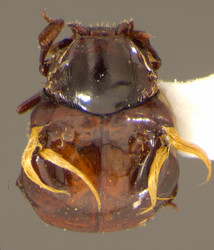Eucurtia
Eucurtia comata
Michael S. CaterinoIntroduction
Eucurtia comata is alone in the genus Eucurtia. It is a highly distinctive species, with greatly exaggerated trichome setae. The species is unusual among Chlamydopsinae in living with termites rather than ants. Mjöberg (1912) described interactions of the beetle and its host, including the termites imbibing some sort of fluid from the apices of the elongated trichomes. No specimens other than Blackburn's original type and the specimen observed by Mjöberg have ever been found.
Analyses by Caterino & Dégallier (2007) placed Eucurtia as the sister to a clade comprising Chlamydopsis and Ectatommiphila. However, they cautioned that too many character states of Eucurtia remain to be resolved to have high confidence in this result. In particular, no males of Eucurtia are known, and some potentially informative genitalia characters have not been examined.
Characteristics
Beyond the unusually elongate trichome setae, Eucurtia comata is characterized by its relatively large size (about 4mm). It also lacks an elevated anterior pronotal margin, though this is true of several Chlamydopsis as well.
References
Caterino. M. S. and Dégallier, N. 2007. A review of the biology and systematics of Chlamydopsinae. Invertebrate Systematics 21:1-28.
Mjöberg, E. 1912. On a new termitophilous genus of the family Histeridae. Entomologisk Tidskrift 33:121–124.
Title Illustrations

| Scientific Name | Eucurtia comata |
|---|---|
| Specimen Condition | Dead Specimen |
| Identified By | Michael S. Caterino |
| View | dorsal |
| Collection | The Natural History Museum, London |
| Type | Holotype |
| Image Use |
 This media file is licensed under the Creative Commons Attribution-ShareAlike License - Version 3.0. This media file is licensed under the Creative Commons Attribution-ShareAlike License - Version 3.0.
|
| Copyright |
©
Michael S. Caterino

|
| Scientific Name | Eucurtia comata |
|---|---|
| Specimen Condition | Dead Specimen |
| Identified By | Michael S. Caterino |
| View | lateral |
| Collection | The Natural History Museum, London |
| Type | Holotype |
| Image Use |
 This media file is licensed under the Creative Commons Attribution-ShareAlike License - Version 3.0. This media file is licensed under the Creative Commons Attribution-ShareAlike License - Version 3.0.
|
| Copyright |
©
Michael S. Caterino

|
About This Page
Michael S. Caterino

Santa Barbara Museum of Natural History, Santa Barbara, California, USA
Correspondence regarding this page should be directed to Michael S. Caterino at
mcaterino@sbnature2.org
Page copyright © 2007 Michael S. Caterino
 Page: Tree of Life
Eucurtia . Eucurtia comata .
Authored by
Michael S. Caterino.
The TEXT of this page is licensed under the
Creative Commons Attribution License - Version 3.0. Note that images and other media
featured on this page are each governed by their own license, and they may or may not be available
for reuse. Click on an image or a media link to access the media data window, which provides the
relevant licensing information. For the general terms and conditions of ToL material reuse and
redistribution, please see the Tree of Life Copyright
Policies.
Page: Tree of Life
Eucurtia . Eucurtia comata .
Authored by
Michael S. Caterino.
The TEXT of this page is licensed under the
Creative Commons Attribution License - Version 3.0. Note that images and other media
featured on this page are each governed by their own license, and they may or may not be available
for reuse. Click on an image or a media link to access the media data window, which provides the
relevant licensing information. For the general terms and conditions of ToL material reuse and
redistribution, please see the Tree of Life Copyright
Policies.
- First online 15 July 2007
- Content changed 15 July 2007
Citing this page:
Caterino, Michael S. 2007. Eucurtia . Eucurtia comata . Version 15 July 2007 (under construction). http://tolweb.org/Eucurtia_comata/9261/2007.07.15 in The Tree of Life Web Project, http://tolweb.org/










 Go to quick links
Go to quick search
Go to navigation for this section of the ToL site
Go to detailed links for the ToL site
Go to quick links
Go to quick search
Go to navigation for this section of the ToL site
Go to detailed links for the ToL site